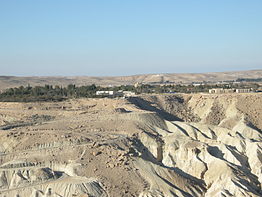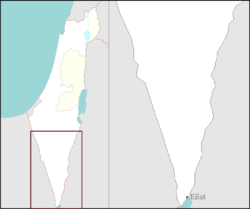- Midreshet Ben-Gurion
-
Midreshet Ben-Gurion
Midreshet Ben Gurion, photographed from Ma'ale DivshonHebrew מִדְרֶשֶׁת בֶּן גּוּרְיוֹן Founded 1963 Council Ramat HaNegev District South Coordinates 30°51′8.27″N 34°47′0.24″E / 30.8522972°N 34.7834°ECoordinates: 30°51′8.27″N 34°47′0.24″E / 30.8522972°N 34.7834°E Population 1,200 (2009) Midreshet Ben-Gurion (Hebrew: מִדְרֶשֶׁת בֶּן גּוּרְיוֹן), also known as Midreshet Sde Boker, is a communal settlement in southern Israel. Located near Sde Boker in the Negev desert, it falls under the jurisdiction of Ramat HaNegev Regional Council. In 2010 it had a population of 1,200.
Building at the site began in 1962, with the first residents moving in to the site in 1963. It was initially a Field School, and was inspired and guided by David Ben-Gurion's vision of building a thriving Jewish culture in the arid Negev. Ben-Gurion and his wife Paula Ben-Gurion are buried on the cliff overlooking the Zin valley.
The village developed into an educational centre and as well as the field school, now hosts the Jacob Blaustein Institutes for Desert Research (part of Ben-Gurion University of the Negev); the Ben Gurion Heritage Institute, which is charged with the study and the dissemination of his writings and offers visitors a multi-media program about the man and his work; as well as a high school where the curriculum emphasizes environmental studies.
Contents
Solar Energy Research centre
The Jacob Blaustein Institutes for Desert Research, a faculty of the Ben-Gurion University of the Negev, has a solar energy research programme that has developed some interesting demonstrations of how the extremes of heat and cold experienced in the desert can be mitigated through efficient storage of heat during the day for release at night.
Among these are an inhabited adobe house that has rational fenestration, with small windows in the northern side and heat collecting concrete prisms in the windows of the south facing wall. The prisms are situated in the rooms. They absorb heat during the day and can be rotated to allow the heat to discharge into the rooms at night. The "chimney" is actually part of an evaporative cooling system that maintains the temperature of the house during the day at bearable levels.
There is a double skin greenhouse that uses copper sulfate solution as a heat screen during the day. The liquid is pumped between the two skins, protects the interior from ultraviolet rays and collects heat. At night the liquid is recirculated returning the heat to the greenhouse.
Dr. David Faiman of the Solar Center has made advancements in the realm of concentrator photovoltaics CPV. Dr. Faiman has produced a CPV unit capable of producing energy at a factor of up to a thousand more than conventional units.[1]
Agriculture and Biotechnology
Researchers at Midreshet Ben-Gurion have made breakthroughs in agriculture and biotechnology relevant to drylands and sustainable agriculture. The STRS1 and STRS2 genes, master controller genes in stress responses, discovered by Dr. Simon Barak and his students in 2006, helped to elucidate some of the more important genes involved with abiotic stress responses [[2]].
Director of the institutes, Avigad Vonshak, made headlines for his discovery, together with Prof. Sammy Boussiba (also of the institutes) of astaxanthin accumulation in green algae [1]. Astaxanthin is an extremely valuable poly-unsaturated fatty acid (PUFA) which is valued for its use as a pigment, nutritional value, and possible use in bio-diesel.
Gallery
References
External links
- Village website (Hebrew).
- High school website (Hebrew)
Moshavim Communal settlements Categories:- Ramat Negev Regional Council
- Education in Israel
- Community settlements in Israel
- Populated places established in 1963
Wikimedia Foundation. 2010.






